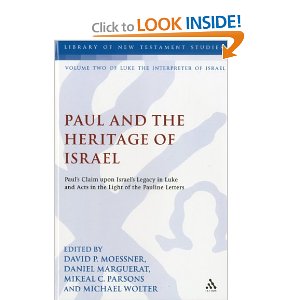The second major portion of Paul and the Heritage of Israel deals with The Figure and Legacy of Paul in Acts. The first essay in this section is an important one by David Moessner.
Moessner situations Acts, quite rightly, as a volume completed in the last couple of decades of the first century when the first generation of witnesses had died off or were no longer able to give credible witness. Written apostolic traditions are proliferating, collections of Paul’s letters are circulating and stirring up controversy and Luke sets out to promote Paul as the star witness to Jesus and to stress Paul’s own view about the rejection and exaltation of Jesus, Israel’s messiah, as the authoritative interpretation of the apostles for the growing nexus of churches. (p. 117).
Interestingly, he quotes John Locke at the outset— “Any testimony, the further off it is from the original truth, the less force and proof it has….the more hands the tradition has successively passed through, the less strength and evidence does it receive from them”. (Essay concerning Human Understanding IV.6.10).
The thesis stated above (before the Locke quote) “is demonstrated by showing how Luke utlilizes rhetorical methods of elaboration (exergasiai) intrinsic to conventions of Hellenistic historiographic ‘narrative arrangement (oikonomia) to portray Paul as Messiah’s chief witness…[by] I. arranging his material on a topic or event (pragmatikos topos) to create a sequence (taxis) according to the criteria of ‘disposition’ or ‘division’ (diairesis), Luke establishes ‘the continuity of narrative’…and by II. linking his volumes together through a recapitulatory preface (prooimion), reconfigures his first volume on ‘all that Jesus began to do and to teach’ as the defining template for all that Jesus continues to do and to teach through his witnesses and thus by, III. binding Paul to the beginning of volume two, enfolds Paul into the beginning of Messiah Jesus and the Twelve such that Paul becomes the incomparable, indispensable ‘witness’ to the beginning of the gospel, and indeed, himself becomes the definitive of the tradition of the Twelve.'” (p. 118). [Note to blog reader– this last unbearably long sentence while crucial, shows what happens to English syntax when a scholar has been reading too much German theologische and exegetical commentary before bedtime].
Moessner is very well read in the necessary Greek literature to be able assess Luke’s style and rhetorical finesse and program and he is right that from the beginning of Greek literature “writing was primarily an aide to persuasive speech” as shown by Plato’s Phaedrus 271d,e.(p. 119 n. 13). The culture was largely oral, and texts supported the orality of the culture. This led to the growing interdependence of oral and written expression and conventions (p. 119). He is absolutely right that Polybius (202-120 B.C.), Diodorus Siculus (Julian period), and Dionysius of Halicarnassus (Augustan period) were all thoroughly immersed in the culture of rhetoric and conceived of their narratives as exercises in persuasion (p. 120). Luke follows in this tradition. [On all of this one should see both the Introduction to my Acts commentary and now the Introduction to Craig Keener’s Acts Commentary– Vol. One]. Events are arranged in a fashion that will persuade the audience about the author’s theses! The linear nature of the narrative reflects how ‘fortune’ has interwoven a sequence of events, which the narrative must mirror. This leads to a diachronic account by and large, as opposed to a region by region account such as we find in Thucydides history.
Moessner p. 121 goes on saying, “by the first century B.C. rhetoric had become an all-encompassing heuristic for compositional performance whether of speaking or writing.” (citing R.L. Enos, Greek Rhetoric before Aristotle (Waveland Press, 1993), pp. 91-140. He is absolutely right about this. This is why a non-rhetorical reading of Acts is always going to be deficient considering that rhetorical convention is guiding how Luke presents not just the speeches in Acts, but the whole narrative arrangement as part of the act of persuasion. Moessner shows how Diodorus stresses that even in a multi-volume work, each volume needs to be rounded off, and have a certain completeness to it, as is the case with Luke and Acts. And yet, as well the second volume will be presented as a continuation. The two volumes are then linked by a recapitulatory Introduction such as we find at the beginning of Acts, not only in first few verses, but in the recapitulation of the story of the Ascension. But the Ascension is presented in Lk. 24 as an event which brings closure to things, but in Acts it is the opening sequence that leads to Pentecost. Jesus must go away and send the promise of the Father from on high.
Moessner demonstrates from examples in Diodorus how narratives are linked together, and volumes as well, and how at the outset of volumes you have a rhetorical preview of coming attractions as in an exordium. Polybius is shown to stress that making a good beginning is crucial, indeed it needs to show the overarching goal of the whole narrative in advance (5.32.1-5). “Therefore we should know that beginnings do not only extend half way, but extend to the end, and both speakers/performers and auditors should take the greatest pains to relate them to their whole” (5.32.5). Beginnings not only reveal the genre of the whole work (see Lk. 1.1-4), they are decisive in determining the character of the whole if we are talking about rhetorical historiography like we find in Polybius, Diodorus, Dionysius, Luke, and for that matter Josephus. Against Thucydides season by season and region by region approach, Dionysius insists “a history narrative should be a flowing and uninterrupted written account” (De. Thucydides 9). “The beginning point is crucial for determining for the audience the quality and completeness of the whole, the purpose and even the scope of the plotted continuity” (p. 127). In Moessner’s view, Luke does something daring in placing Paul at the center of the witness to Jesus that spreads from Jerusalem to Rome, because of course he was controversial, and to many not even a real an apostle. And yet it is Paul who extends the work and word of Jesus, what ‘Jesus continued to do and to teach’, making Paul the ‘servant’ of Isaiah and so written into the very warp and woof of the Scriptures’ witness to Israel’s salvation through ‘the Messiah of God’.
On p. 131, one interesting note is that Moessner parallels the reforming of the 12 as witnesses in Acts 1 to what is said about the disciples in Lk. 6.13– namely that Jesus ‘named them also apostles’. Now this is an interesting note precisely because Luke also downplays the apostolic character of Paul. In the case of the Twelve and in the case of Paul this seems to be a secondary trait, not a primary one. So for instance, in Acts 1, it is the recompleting of the 12 as witnesses that is of interest, not the recompleting of a complete set of apostles. Herein we find one more reason to object to the later title ‘the Acts of the Apostles’. If it had been up to Luke it would have been ‘the Acts of the original witnesses’. For one thing, Lk. 6.13 makes very clear that whatever Luke means by apostle, he means something different than Paul who identifies apostle with having seen the risen Lord. This could hardly characterize the 12 at the juncture in the narrative which Lk. 6.13. The Twelve according to Luke have to have been witnesses since the baptism of John. Not so, the apostles according to Paul. In short, it is mistake to simply equate the Twelve with the apostles, even just on Lukan terms, In any case ‘all the witnesses’ is what Luke is truly exercised about.
But where does Paul fit into this schema? Moessner argues that Luke makes Paul become the definer and defender of the ‘from the beginning witness’of disciples and apostles to ‘all that Jesus began to do and teach’ (see Paul’s speeches in Acts).(p. 134). Moessner also points to Is. 49.6 in Acts 13.47 showing explicitly that Paul sees his mission as that of the servant of Isaiah, and his turning from Jews to Gentiles when the former reject the good news as given a basis or rationale in Is. 40-55, in this case Isaiah 49.1-6 (see p. 139). Ironically, it is Paul who fulfills the mandate ‘to the nations’ announced in Acts 1.8.
Finally, Moessner is able to point (p. 147) to Ps. Sol. 8.15 which shows that in the Jewish mindset ‘the ends of the earth’ is in this case a reference to Rome, and so Paul is indeed the servant/witness who proclaims the good news to the ends of the earth so those who are there may turn and be saved (Is. 45.22). Hence, Paul is seen at the end of Acts 28 as proclaiming this good news for some two years unhindered, even though most Jews are unconvinced and only gentiles in the main are responding. The Scriptures have been opened and even fulfilled, at the ends of the earth.














